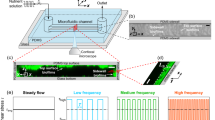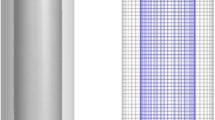Abstract
This work investigates the effect of flow rate variation on mass transfer and on the development of Escherichia coli biofilms on a flow cell reactor under turbulent flow conditions. Computational fluid dynamics (CFD) was used to assess the applicability of this reactor for the simulation of industrial and biomedical biofilms and the numerical results were validated by streak photography. Two flow rates of 374 and 242 L h−1 (corresponding to Reynolds numbers of 6,720 and 4,350) were tested and wall shear stresses between 0.183 and 0.511 Pa were predicted in the flow cell reactor. External mass transfer coefficients of 1.38 × 10−5 and 9.64 × 10−6 m s−1 were obtained for the higher and lower flow rates, respectively. Biofilm formation was favored at the lowest flow rate because shear stress effects were more important than mass transfer limitations. This flow cell reactor generates wall shear stresses that are similar to those found in some industrial and biomedical settings, thus it is likely that the results obtained on this work can be used in the development of biofilm control strategies in both scenarios.




Similar content being viewed by others
Abbreviations
- 1/b :
-
Parameter related to the mechanical strength of the biofilm (T)
- C :
-
Nutrient concentration in the biofilm (M L−3)
- C b :
-
Bulk liquid nutrient concentration (M L−3)
- C s :
-
Nutrient concentration at the biofilm surface (M L−3)
- d :
-
Hydraulic diameter (L)
- D :
-
Molecular diffusivity of growth-limiting nutrient in water (7.0 × 10−10 m2 s−1 at 30 °C for glucose) (L2 T−1)
- D f :
-
Effective diffusivity of growth-limiting nutrient in the biofilm (L2 T−1)
- J p :
-
Biofilm production flux (Mbiofilm L−2 T−1)
- K m :
-
External (liquid) mass transfer coefficient (L T−1)
- L f :
-
Average biofilm thickness (L)
- m f :
-
Mass of biofilm per unit surface area (Mbiofilm L −2biofilm )
- N :
-
Nutrient flux to the biofilm surface (M L2 T−1)
- Q :
-
Flow rate used in each experiment (L3 T−1)
- Re :
-
Reynolds number (ρ v d μ −1)
- Sc :
-
Schmidt number (μ ρ −1 D −1)
- Sh :
-
Sherwood number (K m d D −1)
- t :
-
Time (T)
- v :
-
Flow velocity (L T−1)
- V :
-
Total system volume (L3)
- μ b :
-
Biofilm specific production rate (T−1)
- μ :
-
Viscosity (M L−1 T−1)
- ρ :
-
Density (M L−3)
- σ :
-
Residence time in whole system (V Q −1) (T)
References
Petrova OE, Sauer K (2012) Sticky situations—key components that control bacterial surface attachment. J Bacteriol 194:2413–2425
Nikolaev Y, Plakunov V (2007) Biofilm—“City of microbes” or an analogue of multicellular organisms? Microbiology 76:125–138
Azevedo NF, Pinto AR, Reis NM, Vieira MJ, Keevil CW (2006) Shear stress, temperature, and inoculation concentration influence the adhesion of water-stressed Helicobacter pylori to stainless steel 304 and polypropylene. Appl Environ Microbiol 72:2936–2941
Hunt SM, Werner EM, Huang B, Hamilton MA, Stewart PS (2004) Hypothesis for the role of nutrient starvation in biofilm detachment. Appl Environ Microbiol 70:7418–7425
Stoodley P, Dodds I, Boyle JD, Lappin-Scott HM (1998) Influence of hydrodynamics and nutrients on biofilm structure. J Appl Microbiol 85:19S–28S
Singh R, Paul D, Jain RK (2006) Biofilms: implications in bioremediation. Trends Microbiol 14:389–397
Qureshi N, Annous B, Ezeji T, Karcher P, Maddox I (2005) Biofilm reactors for industrial bioconversion processes: employing potential of enhanced reaction rates. Microb Cell Fact 4:24
Costerton JW, Stewart PS (2001) Battling biofilms—the war is against bacterial colonies that cause some of the most tenacious infections known. The weapon is knowledge of the enemy’s communication system. Sci Am 285:74–81
Costerton JW, Stewart PS, Greenberg EP (1999) Bacterial biofilms: a common cause of persistent infections. Science 284:1318–1322
Shi X, Zhu X (2009) Biofilm formation and food safety in food industries. Trends Food Sci Technol 20:407–413
Van Houdt R, Michiels CW (2010) Biofilm formation and the food industry, a focus on the bacterial outer surface. J Appl Microbiol 109:1117–1131
Georgiadis MC, Rotstein GE, Macchietto S (1998) Modelling and simulation of complex plate heat exchanger arrangements under milk fouling. Comput Chem Eng 22(Suppl 1):S331–S338
Juhna T, Birzniece D, Larsson S, Zulenkovs D, Sharipo A, Azevedo NF, Menard-Szczebara F, Castagnet S, Feliers C, Keevil CW (2007) Detection of Escherichia coli in biofilms from pipe samples and coupons in drinking water distribution networks. Appl Environ Microbiol 73:7456–7464
Dourou D, Beauchamp CS, Yoon Y, Geornaras I, Belk KE, Smith GC, Nychas G-JE, Sofos JN (2011) Attachment and biofilm formation by Escherichia coli O157:H7 at different temperatures, on various food-contact surfaces encountered in beef processing. Int J Food Microbiol 149:262–268
Castonguay MH, van der Schaaf S, Koester W, Krooneman J, van der Meer W, Harmsen H, Landini P (2006) Biofilm formation by Escherichia coli is stimulated by synergistic interactions and co-adhesion mechanisms with adherence-proficient bacteria. Res Microbiol 157:471–478
Chen MJ, Zhang Z, Bott TR (2005) Effects of operating conditions on the adhesive strength of Pseudomonas fluorescens biofilms in tubes. Colloid Surface B 43:61–71
Brooks DE, Trust TJ (1983) Enhancement of bacterial adhesion by shear forces: characterization of the haemagglutination induced by Aeromonas salmonicida strain 438. J Gen Microbiol 129:3661–3669
Finger EB, Purl KD, Alon R, Lawrence MB, von Andrian UH, Springer TA (1996) Adhesion through L-selectin requires a threshold hydrodynamic shear. Nature 379:266–269
Mohamed N, Rainier TR, Ross JM (2000) Novel experimental study of receptor-mediated bacterial adhesion under the influence of fluid shear. Biotechnol Bioeng 68:628–636
Jensen BBB, Friis A, Benezech T, Legentilhomme P, Lelievre C (2005) Local wall shear stress variations predicted by computational fluid dynamics for hygienic design. Food Bioprod Process 83:53–60
Vieira MJ, Melo LF (1999) Intrinsic kinetics of biofilms formed under turbulent flow and low substrate concentrations. Bioprocess Biosyst Eng 20:369–375
Beyenal H, Lewandowski Z (2002) Internal and external mass transfer in biofilms grown at various flow velocities. Biotechnol Prog 18:55–61
Picioreanu C, VanLoosdrecht MCM, Heijnen JJ (2000) Effect of diffusive and convective substrate transport on biofilm structure formation: a two-dimensional modeling study. Biotechnol Bioeng 69:504–515
Perry RH, Green DW (1997) Perry’s chemical engineers’ handbook. McGraw-Hill, New York
Melo LF, Vieira MJ (1999) Physical stability and biological activity of biofilms under turbulent flow and low substrate concentration. Bioprocess Eng 20:363–368
Issa RI (1986) Solution of the implicitly discutised fluid flow equations by operating-splitting. J Comput Phys 62:40–65
Leonard BP (1979) A stable and accurate convective modelling procedure based on quadratic upstream interpolation. Comput Methods Appl Mech Eng 19:59–98
Menter FR (1994) Two-equation eddy-viscosity turbulence models for engineering applications. AIAA J 32:1598–1605
Launder BE, Spalding DB (1972) Mathematical models of turbulence. Academic Press Inc, London
Wilcox D (1998) Turbulence modeling for CFD. DCW Industries Inc, California
Teodósio JS, Simões M, Alves MA, Melo LF, Mergulhão FJ (2012) Setup and validation of flow cell systems for biofouling simulation in industrial settings. Sci World J ID 361496
Teodósio JS, Simões M, Melo LF, Mergulhão FJ (2011) Flow cell hydrodynamics and their effects on E. coli biofilm formation under different nutrient conditions and turbulent flow. Biofouling 27:1–11
Simões M, Simões LC, Vieira MJ (2008) Physiology and behavior of Pseudomonas fluorescens single and dual strain biofilms under diverse hydrodynamics stresses. Int J Food Microbiol 128:309–316
Teodósio JS, Simões M, Mergulhão FJ (2012) The influence of non-conjugative Escherichia coli plasmids on biofilm formation and resistance. J Appl Microbiol 113:373–382
Miller GL (1959) Use of dinitrosalicylic acid reagent for determination of reducing sugar. J Am Chem Soc 31:426–428
Stoodley P, Warwood BK (2003) In: Lens P, O’Flaherty V, Moran AP, Stoodley P, Mahony T (eds) Use of flow cells and annular reactors to study biofilms. IWA Publishing Place, London
Salek MM, Jones SM, Martinuzzi RJ (2009) The influence of flow cell geometry related shear stresses on the distribution, structure and susceptibility of Pseudomonas aeruginosa 01 biofilms. Biofouling 25:711–725
Moreira JMR, Gomes LC, Araújo JDP, Miranda JM, Simões M, Melo LF, Mergulhão FJ (2013) The effect of glucose concentration and shaking conditions on Escherichia coli biofilm formation in microtiter plates. Chem Eng Sci 94:192–199
Jun S, Puri VM (2005) 3D milk-fouling model of plate heat exchangers using computational fluid dynamics. Int J Dairy Technol 58:214–224
Lantz J, Renner J, Karlsson M (2011) Wall shear stress in a subject specific human aorta—influence of fluid-structure interaction. Int J Appl Mech 3:759–778
Ahmed S, Seraji MT, Jahedi J, Hashib MA (2011) CFD simulation of turbulence promoters in a tubular membrane channel. Desalination 276:191–198
Konuklar G, Gunasekaran S (2002) Rennet-induced milk coagulation by continuous steady shear stress. J Colloid Interface Sci 250:149–158
Augst AD, Ariff B, McG. Thom SAG, Xu XY, Hughes AD (2007) Analysis of complex flow and the relationship between blood pressure, wall shear stress, and intima-media thickness in the human carotid artery. Am J Physiol-Heart 293:H1031–H1037
Malek AM, Alper SL, Izumo S (1999) Hemodynamic shear stress and its role in atherosclerosis. J Am Med Assoc 282:2035–2042
Liu Y, Tay J (2002) The essential role of hydrodynamic shear force in the formation of biofilm and granular sludge. Water Res 36:1653–1665
Stewart PS, Franklin MJ (2008) Physiological heterogeneity in biofilms. Nat Rev Microbiol 6:199–210
Stoodley P, deBeer D, Lewandowski Z (1994) Liquid flow in biofilm systems. Appl Environ Microbiol 60:2711–2716
Stoodley P, Yang S, Lappin-Scott H, Lewandowski Z (1997) Relationship between mass transfer coefficient and liquid flow velocity in heterogenous biofilms using microelectrodes and confocal microscopy. Biotechnol Bioeng 56:681–688
Inauen W, Baumgartner HR, Bombeli T, Haeberli A, Straub PW (1990) Dose- and shear rate-dependent effects of heparin on thrombogenesis induced by rabbit aorta subendothelium exposed to flowing human blood. Arterioscler Thromb Vasc Biol 10:607–615
Acknowledgments
The authors acknowledge the financial support provided by Operational Programme for Competitiveness Factors—COMPETE, European Fund for Regional Development—FEDER and by Portuguese Foundation for Science and Technology—FCT through Projects MIT-Pt/BS-BB/0082/2008 and PTDC/EBB-BIO/104940/2008. Manuel Moreira Alves (CEFT, Faculty of Engineering, University of Porto) is acknowledged for the numerical simulations and revision of the manuscript.
Author information
Authors and Affiliations
Corresponding author
Rights and permissions
About this article
Cite this article
Moreira, J.M.R., Teodósio, J.S., Silva, F.C. et al. Influence of flow rate variation on the development of Escherichia coli biofilms. Bioprocess Biosyst Eng 36, 1787–1796 (2013). https://doi.org/10.1007/s00449-013-0954-y
Received:
Accepted:
Published:
Issue Date:
DOI: https://doi.org/10.1007/s00449-013-0954-y




